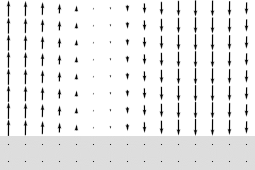
Heinrich Rudolf Hertz was a German physicist who first conclusively proved the existence of the electromagnetic waves predicted by James Clerk Maxwell's equations of electromagnetism. The unit of frequency, cycle per second, was named the "hertz" in his honor.

Karl Ferdinand Braun was a German electrical engineer, inventor, physicist and Nobel laureate in physics. Braun contributed significantly to the development of radio and television technology: he shared the 1909 Nobel Prize in Physics with Guglielmo Marconi "for their contributions to the development of wireless telegraphy", was a founder of Telefunken, one of the pioneering communications and television companies, and has been both called the "father of television" and the co-father of the radio telegraphy, together with Marconi.

In physics, a surface wave is a mechanical wave that propagates along the interface between differing media. A common example is gravity waves along the surface of liquids, such as ocean waves. Gravity waves can also occur within liquids, at the interface between two fluids with different densities. Elastic surface waves can travel along the surface of solids, such as Rayleigh or Love waves. Electromagnetic waves can also propagate as "surface waves" in that they can be guided along with a refractive index gradient or along an interface between two media having different dielectric constants. In radio transmission, a ground wave is a guided wave that propagates close to the surface of the Earth.

Longitudinal waves are waves in which the vibration of the medium is parallel to the direction the wave travels and displacement of the medium is in the same direction of the wave propagation. Mechanical longitudinal waves are also called compressional or compression waves, because they produce compression and rarefaction when traveling through a medium, and pressure waves, because they produce increases and decreases in pressure. A wave along the length of a stretched Slinky toy, where the distance between coils increases and decreases, is a good visualization. Real-world examples include sound waves and seismic P-waves.

Wilhelm Carl Werner Otto Fritz Franz Wien was a German physicist who, in 1893, used theories about heat and electromagnetism to deduce Wien's displacement law, which calculates the emission of a blackbody at any temperature from the emission at any one reference temperature.

Thermionic emission is the liberation of electrons from an electrode by virtue of its temperature. This occurs because the thermal energy given to the charge carrier overcomes the work function of the material. The charge carriers can be electrons or ions, and in older literature are sometimes referred to as thermions. After emission, a charge that is equal in magnitude and opposite in sign to the total charge emitted is initially left behind in the emitting region. But if the emitter is connected to a battery, the charge left behind is neutralized by charge supplied by the battery as the emitted charge carriers move away from the emitter, and finally the emitter will be in the same state as it was before emission.
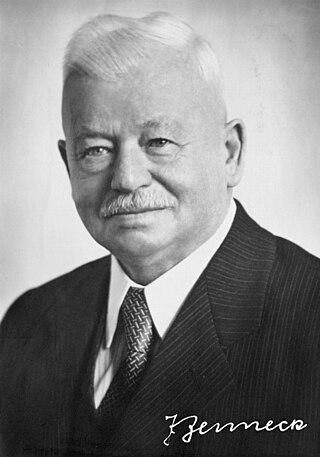
Jonathan Adolf Wilhelm Zenneck was a German physicist and electrical engineer who contributed to researches in radio circuit performance and to the scientific and educational contributions to the literature of the pioneer radio art. Zenneck improved the Braun cathode ray tube by adding a second deflection structure at right angles to the first, which allowed two-dimensional viewing of a waveform. This two-dimensional display is fundamental to the oscilloscope.
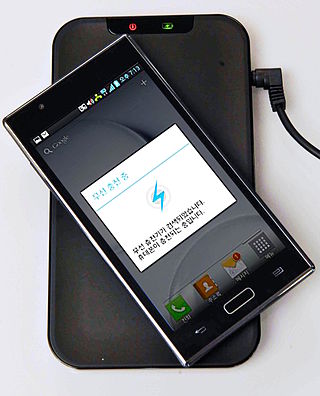
Wireless power transfer (WPT), wireless power transmission, wireless energy transmission (WET), or electromagnetic power transfer is the transmission of electrical energy without wires as a physical link. In a wireless power transmission system, a transmitter device, driven by electric power from a power source, generates a time-varying electromagnetic field, which transmits power across space to a receiver device, which extracts power from the field and supplies it to an electrical load. The technology of wireless power transmission can eliminate the use of the wires and batteries, thus increasing the mobility, convenience, and safety of an electronic device for all users. Wireless power transfer is useful to power electrical devices where interconnecting wires are inconvenient, hazardous, or are not possible.
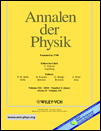
Annalen der Physik is one of the oldest scientific journals on physics; it has been published since 1799. The journal publishes original, peer-reviewed papers on experimental, theoretical, applied, and mathematical physics and related areas. The editor-in-chief is Stefan Hildebrandt. Prior to 2008, its ISO 4 abbreviation was Ann. Phys. (Leipzig), after 2008 it became Ann. Phys. (Berl.).
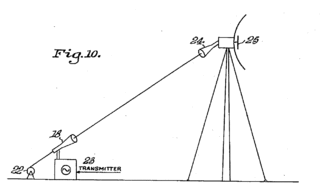
A Goubau line or Sommerfeld–Goubau line, or G-line for short, is a single-wire transmission line used to conduct radio waves at UHF and microwave frequencies. The dielectric coated transmission line was invented by F. Harms in 1907 and George J. E. Goubau in 1950, based on work on surface waves on wires from 1899 by Arnold Sommerfeld. It is used as a feedline at UHF to link high frequency transmitters and receivers to their antennas, and in scientific research.

Leo Graetz was a German physicist. He was born in Breslau, Germany, and was the son of historian Heinrich Graetz.

In radio-frequency engineering and communications engineering, waveguide is a hollow metal pipe used to carry radio waves. This type of waveguide is used as a transmission line mostly at microwave frequencies, for such purposes as connecting microwave transmitters and receivers to their antennas, in equipment such as microwave ovens, radar sets, satellite communications, and microwave radio links.
Herman William March was a mathematician and physicist.

Gustav Herglotz was a German Bohemian physicist best known for his works on the theory of relativity and seismology.
Jakob Johann Laub was a physicist from Austria-Hungary, who is best known for his work with Albert Einstein in the early period of special relativity.
Paul Gerber was a German physics teacher. He studied in Berlin from 1872 to 1875. In 1877 he became a teacher at the Realgymnasium in Stargard in Pommern. Gerber is known for his controversial work on the speed of gravity and the perihelion shift of Mercury's orbit.

Vladimir Sergeyevitch Ignatowski, or Waldemar Sergius von Ignatowsky and similar names in other publications, was a Russian physicist.

Otto Heinrich Wiener was a German physicist.
Hermann Fritz Gustav Goos was a German physicist and astronomer.
In physics, the Weyl expansion, also known as the Weyl identity or angular spectrum expansion, expresses an outgoing spherical wave as a linear combination of plane waves. In a Cartesian coordinate system, it can be denoted as
